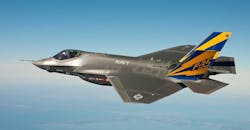Lockheed-Martin F-35’s Full Rate Production to Be Delayed Up to 13 Months Longer
The Pentagon is delaying a decision to put Lockheed Martin Corp.(IW500/24)’s F-35 into full production by as long as 13 more months because of a tardy start to simulation testing against the most advanced air defense threats posed by Russia and China, according to the military’s chief weapons buyer.
A full-rate production decision was scheduled for December, but the F-35 program office decided this week with the concurrence of Ellen Lord, the undersecretary of defense for acquisition, that more time was needed to initiate the intensive simulator testing that has yet to begin.
It’s only the latest in a series of delays: The decision on full-rate production -- the most profitable phase for a contractor -- was originally scheduled for 2012 when Lockheed won the contract for the fighter jet in late 2001.
Even though the most rigorous combat testing hasn’t been completed, more than 435 in a planned fleet of more than 3,000 F-35s for the U.S. and allies already have been delivered as of this month. The Marine Corps and Air Force have flown the jets in combat missions against Middle East targets -- but only those that pose little or no air-to-air or air-defense threats.
Full-rate production will be a seal of approval from the Defense Department to taxpayers that the $428 billion program has been fully tested, deemed effective against the highest-level threats and can be produced efficiently. Bethesda, Maryland-based Lockheed is currently operating under an 11th “low-rate” production contract.
“I need to look at the whole fact set and work with the team” before making a decision, likely to come before Christmas, about the extent of the delay, Lord said in an interview after a Pentagon news conference. She said she wants to “inform Congress as well” and “have a conversation with them.”
While the aircraft has flown hundreds of aerial exercises in current combat testing, it must also be evaluated against the most sophisticated threats in simulators that can’t be replicated in flight.
The F-35 pilot will fly in a “fully functioning simulator with a full 360-degree” view that depicts air and ground threats and incorporates allied aircraft as well, the F-35 program office said in a statement. Data from the flying exercises is used to prepare and certify the simulator, which hasn’t been completed yet, the office said.
Lockheed ‘Confident’
“We are confident the full F-35 enterprise is prepared for full-rate production and ready to meet growing customer demand,” Lockheed spokeswoman Carolyn Nelson said in an email.
She said the company has “delivered on all requirements” for the software needed by the Naval Air Systems Command, which will host the simulations, and is “providing our full support to ensure successful integration and testing as soon as possible.”
The remaining testing includes 64 simulator mission trials and some weapons and cybersecurity evaluations, Lieutenant Colonel Michael Andrews, a spokesman for the Pentagon’s test office, said on an email. This data is required to complete a congressionally mandated report needed for a full-production decision.
“A high-fidelity simulation environment is often the only way to test the full capabilities of a weapons system against modern threats, in operationally representative scenarios and densities,” he said.
The Pentagon is expected to soon announce a block buy of more than 400 F-35s for the 12th, 13th and 14th low-rate production contracts.
About the Author
Bloomberg
Licensed content from Bloomberg, copyright 2016.
